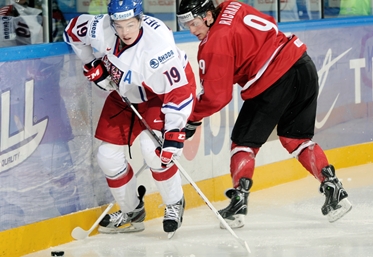Building the perfect body
Building the perfect body
U20 stars stress diet and conditioning

 Czech forward Tomas Hertl (left) achieved an impressive 65.7 VO2 max score at the 2012 NHL Draft Combine. He also got an OT winner against the Swiss in Ufa. Photo: Richard Wolowicz / HHOF-IIHF Images
Czech forward Tomas Hertl (left) achieved an impressive 65.7 VO2 max score at the 2012 NHL Draft Combine. He also got an OT winner against the Swiss in Ufa. Photo: Richard Wolowicz / HHOF-IIHF Images
Whether it’s a matter of conditioning, diet, or sheer size, the 21st-century U20 player often compares favourably to his 20th-century counterparts in senior IIHF competition or the NHL in a physical sense. It just takes a few examples to bear this observation out.
Take cardiovascular fitness, as indicated by VO2 max testing. This measures the maximum amount of oxygen that an person can use during intense or maximal exercise.
At the 2012 NHL Draft Combine, numerous players now participating in Ufa were tested. The top VO2 max results went to Czech forward Tomas Hertl, who scored 65.7. Sweden’s Sebastian Collberg wasn’t far behind at 64.4.
By comparison, according to Al Strachan’s 2005 book Go to the Net: Eight Goals that Changed the Game, a reading of 59 was considered great in the NHL of the 1970s.
Nutrition has come a long way too.
Back in the day, it wasn’t unusual for North American pros to chow down on a steak and baked potato with sour cream as their pre-game meal. (Today’s players are more likely to go for chicken and pastas with some vegetables on the side.)
Another example: at one point in their rookie season of 1980-81 with the Edmonton Oilers, future superstars Paul Coffey (19) and Jari Kurri (20) seemed to be running out of gas. The reason? They were rooming together in Edmonton, and the club found out neither of them knew how to cook at home. They often subsisted on snack food and cookies when they weren’t at team meals.
Needless to say, that sort of thing rarely happens today.
For instance, Hockey Canada goes to extraordinary lengths to ensure its U20 team gets food that not only provides the players with the proper fuel for their bodies, but is also like what they eat in Canada. Each year, a chef is part of the entourage.
Here in Ufa, Calgary-based chefs Andrew Gass and Jeff Hanna, who owns several restaurants in the Alberta city, are responsible for Team Canada’s meals. (See video interview.) At past tournaments, Gass has dished up everything from lemon chicken to meat lasagna for his hungry U20 diners.
With today’s emphasis on eating right and working out hard, it’s not surprising we’re seeing some big bodies at the World Juniors.
Look at Team USA. On average, they stand 185 cm tall (6-foot-1) and weigh 89 kg (196 lbs). That’s remarkably sizable for guys whose average age is 19 years and three months.
To put it in perspective, according to the statistics on hockeydb.com, it’s exactly the same size as both Russia’s Valeri Kamensky, a member of the IIHF’s Triple Gold Club (Olympic gold, World Championship gold, and the Stanley Cup), and Canada’s Steven Stamkos, a two-time winner of the NHL’s Rocket Richard Trophy as the league’s leading goal-scorer. Kamensky earned World Junior gold in 1986 and Stamkos in 2008.
Will many – or any – of the players at the 2013 World Juniors go on to loom as large in the history of hockey as the two aforementioned stars? It’s too early to say. But you don’t need a crystal ball to see that they’re already taking care of their bodies like pros.
Back to Overview





















































